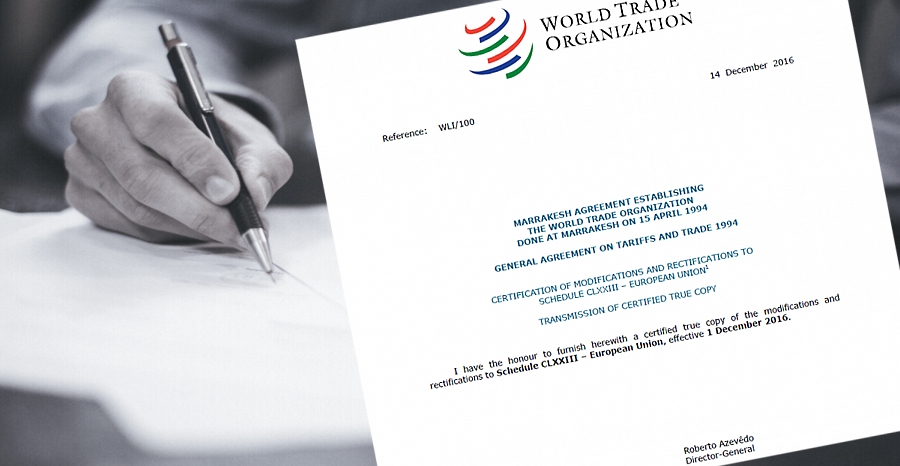UPDATE: on October 17, 2017, the EU circulated revised goods “schedules” for all its 28 members. If no WTO member objects these could be certified in three months. Apart from accounting for the expansion to 28, the revisions include other modifications, including ending agricultural export subsidies.
For the first time since the WTO was set up in 1995, the EU will then be up-to-date with its goods schedules (but not services), until the UK leaves.
The documents using code number G/MA/TAR/RS/506 are visibly listed on the WTO website but remain unavailable to the public until they are certified.
By Peter Ungphakorn
POSTED FEBRUARY 4, 2017 | UPDATED OCTOBER 22, 2017
Some pretty important documents were issued in Geneva by the World Trade Organization (WTO) on December 14, 2016 as Europe started to close down for Christmas and the New Year. They have flown under the radar.
Twelve years after the EU expanded from 15 to 25 members on 1 May 2004, it now has revised commitments on tariffs, tariff quotas and agricultural subsidies to take into account the addition of those 10 new members (you can download them below).
CONTINUE READING OR JUMP TO
What is a WTO schedule? | Goods | Services | DOWNLOAD: the EU–25’s goods schedules | The UK’s post-Brexit goods schedule | EU enlargements over the years
Because the UK is an EU member, its commitments are bundled with the EU’s, so these are also the UK’s latest certified commitments.
For the UK, this means that re-establishing its own post-Brexit commitments in the WTO can be based on EU commitments that are closer to what they should be for the full 28-member union.
Next up: accounting for Bulgaria and Romania, which joined in 2007, to become EU–27, then Croatia (2013) for EU–28; and then subtracting the UK to go back to EU–27.
What is a WTO schedule?
To recap: a WTO “schedule” is essentially a negotiated commitment on how a WTO member agrees to curb protectionist policies. Countries have schedules for goods (including agriculture) and services.
They are called “schedules” because when a negotiation is concluded, the promised changes are phased in according to timetables, which are also set out in the schedules.
In other words, schedules are tools for reducing tariff protection, agricultural subsidies and barriers to trade in services.
Goods
This is what a goods schedule contains:
For general import duties (or “tariffs”) on goods, the schedule sets legally binding ceilings (the “bound rates” of tariffs). The country is free to charge a duty (an “applied rate”) below the ceiling for that product, but not to go above it without renegotiating and offering compensation. These tariffs are known as “most-favoured nation” tariffs (MFN, essentially non-preferential equal treatment for products from all sources). They are also the legally bound rates for quantities outside tariff quotas.

For tariff quotas (or tariff-rate quotas, TRQs), the schedule sets out the quantity that can be imported at a lower duty or duty-free. The country can set a lower in-quota duty or expand the eligible quantity beyond the legally bound amount. But if it wants to raise the in-quota duty above the legally bound rate, or reduce the eligible quantity to less than the legally bound amount, again it has to renegotiate and offer compensation.

For agricultural domestic support — subsidies given to the sector within the country — the schedule has an agreed ceiling on the total amount of “trade-distorting” support provided to farmers, a figure known as the “aggregate measurement of support” (AMS, sometimes called “Amber Box”).
Support is considered to distort trade if it has an impact on prices or production quantities. More details are here. Most countries have nothing on AMS in their schedules because they were not major subsidisers when the support limits were negotiated in the 1980s and 1990s. Some (such as the EU, US and others) are allowed AMS support, but had to reduce it as part of the negotiated liberalisation.
All countries can still use a conceptually small amount of trade-distorting support, known as “de minimis”. For developed countries, this is 5% of the value of production for developed countries (either for specific products or for agriculture generally), 10% for developing countries, and 8.5% for China. Although “de minimis” support is of the same type as AMS, it is not counted against the AMS limits for those countries that have them.
For agricultural export subsidies, the schedules also set legally bound limits on both the amount of money given in subsidy and the export quantities that are subsidised.
More information: on tariffs and disciplines in agriculture

Services
WTO members also have separate schedules on services. These are complicated documents listing when a county will allow foreign services to enter its markets, each of the many types of services (banking, insurance, telecommunications, tourism, professional, and so on) including commitments on each of four “modes”:
- Mode 1 “cross-border supply” — services supplied from one country to another (e.g. international telephone calls)
- Mode 2 “consumption abroad” — consumers or firms making use of a service in another country (e.g. tourism
- Mode 3 “commercial presence” a foreign company setting up subsidiaries or branches to provide services in another country (e.g. foreign banks setting up operations in a country
- Mode 4 “presence of natural persons” — individuals travelling from their own country to supply services in another (e.g. fashion models or consultants)
More information: on services

The EU–25’s goods schedules — download
The WTO document code number for the EU–25’s goods schedule is WT/LET/1220. This actually consists of covering letters and four attachments. They can be downloaded from the list below (the files are correct at the time of writing), or by going to WTO DocsOnline, https://docs.wto.org, and searching for WT/LET/1220:
- Cover letters (pdf)
- Agricultural tariffs, tariff quotas, processed agricultural products (PAPs) and the banana agreement (pdf or Excel)
- Non-agricultural tariffs and tariff quotas (pdf). Also “mdb” database format, downloadable from WTO DocsOnline (above). I have created an Excel file from the mdb file. (NAMA = non-agricultural market access)
- Duty-free trade in pharmaceutical products (pdf or Excel)
- Agricultural subsidies, including an agreement on oilseeds (pdf or Excel)
The UK’s post-Brexit goods schedule
Finally, the implications for extracting the UK’s goods schedule from the EU’s are discussed elsewhere in this blog: agricultural tariffs, agricultural tariff quotas, processed agricultural products, extracting the UK’s schedule. See also this free-to-view AgraEurope article.
 EU enlargement
EU enlargement
![]()
EU ENLARGEMENTS OVER THE YEARS
(More details here)
January 1, 1958 (under GATT) — 6 founder members
1. Belgium — 2. Germany — 3. France — 4. Italy — 5. Luxembourg — 6. Netherlands
January 1, 1973 — 3 new members
7. Denmark — 8. Ireland — 9. United Kingdom (left the EU February 1, 2020)
January 1, 1981 — 1 new member
10. Greece
January 1, 1986 — 2 new members
11. Spain — 12. Portugal
January 1, 1995 (WTO created) — 3 new members
13. Austria — 14. Finland — 15. Sweden
May 1, 2004 — 10 new members
16. Czech Republic — 17. Estonia — 18. Cyprus — 19. Latvia — 20. Lithuania — 21. Hungary — 22. Malta — 23. Poland — 24. Slovenia — 25. Slovakia
January 1, 2007 — 2 new members
26. Bulgaria — 27. Romania
July 1, 2013 — 1 new member
28. Croatia
Updates:
February 4, 2017 — removed incorrect information on EU committing zero export subsidies
February 5, 2017 — added screenshots from the EU–25’s goods schedule
October 22, 2017 — update on EU–28 goods schedule
Photo credits:
♦ Pexels licence, Pixabay licence



